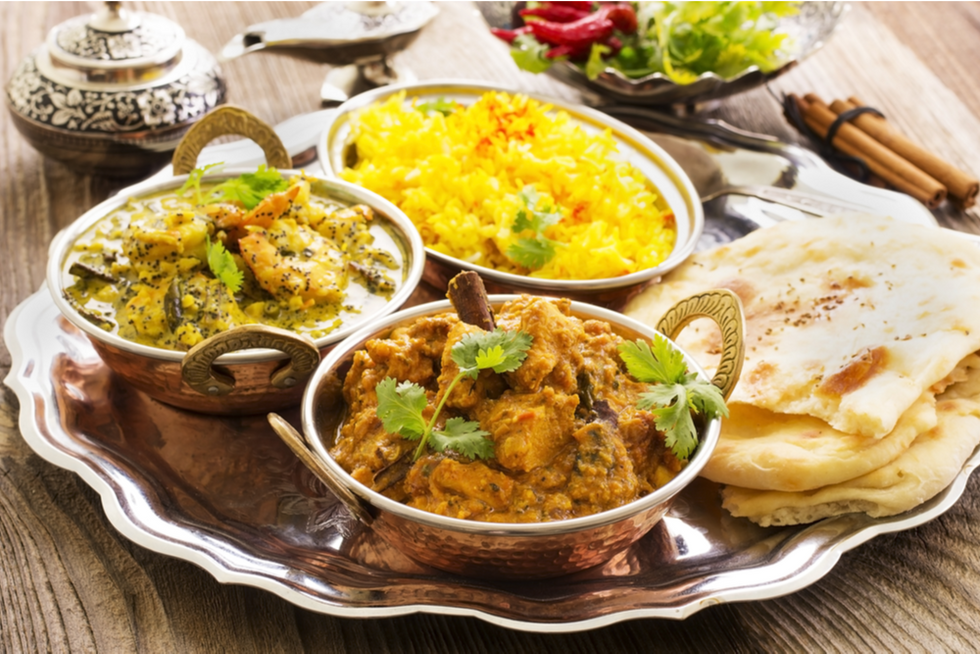Indian food is an experience like no other! From the vibrant colors to the exotic spices, each bite of Indian cuisine will tantalize your taste buds and awaken all five senses. Whether you’re looking for something spicy or mild, there are plenty of dishes to choose from that offer a unique flavor profile unlike any other type of cuisine. So what’s so special about India's food? Let’s take a closer look and explore why it stands out among all other types of world cuisines.
The first thing that makes Indian food stand apart from its counterparts is its bold use of spices. Unlike many Western dishes which can be bland and lack complexity, Indian dishes rely on layers upon layers of spices to create intense flavors that burst in your mouth with every bite. The most common ingredients include cumin, coriander, turmeric, garam masala, ginger, garlic and chili peppers – just to name a few!
Finally, another reason why people around the world love Indian food is because it offers an incredible variety when it comes to texture. You can find anything from creamy curries to crunchy samosas - whether you prefer something light or heartier fare, there’s sure to be something on the menu that appeals to everyone's individual tastes. With such a wide range available at almost every restaurant specializing in this cuisine, you're guaranteed not to get bored!
Overview
Indian food is truly unique, with a range of flavors and textures that come together to create an unforgettable dining experience. The cuisine draws on ancient traditions dating back centuries, as well as modern interpretations from around the world. From fragrant curries to savory tandoori dishes, there's something for every taste bud. Indian food has its own distinct flavor profile thanks to a combination of spices like cumin, coriander, turmeric, cardamom and cinnamon - all staples in traditional cooking. These spices are used not only for their rich flavor but also for their medicinal properties; many believe they can help reduce inflammation and improve digestion. In addition to these classic spices, Indian cooks often use fresh herbs such as mint or cilantro to add complexity and depth to recipes. There are so many delicious options available when it comes to Indian food! Whether you're looking for something spicy and aromatic or milder fare with subtle hints of sweetness, the country's diverse culinary scene won't disappoint.
Regional Diversity
Indian food is an incredibly diverse cuisine, with different regional cooking styles across the country. In the north of India, you can find rich curries and tandoori dishes like naan and paneer. The south of India has a range of delicious dosas, idlis, sambar, and vegetable-based curries. There are also unique regional variations of popular dishes such as biryani in Kerala or fish curry in Goa.
In addition to these regional specialties, Indian food often features distinct flavors that bring out its uniqueness. Spices like cumin, coriander, turmeric, cardamom and chillies are used to make flavorful sauces and gravies that accompany many classic dishes. Herbs such as ginger, garlic and mint add layers of flavor to various recipes too. All these ingredients work together to create mouthwatering meals that have become famous around the world for their complex yet tantalizing tastes. With so much variety on offer from each region of India’s culinary landscape it's no wonder why this type of cuisine is beloved globally!
Spices And Herbs
Indian food is renowned for its use of spices and herbs. A combination of different flavors, textures, and smells create a unique taste experience that's hard to replicate elsewhere. The most common ingredients used in Indian cuisine are cumin, coriander, turmeric, cardamom, cloves, chili peppers, bay leaves, ginger root and garlic. These aromatic herbs and spices give curries their signature flavor profile.
The diverse range of spices not only gives dishes an abundance of flavor but also offers many health benefits as well. For example, the active ingredient found in turmeric has been linked to reducing inflammation and aiding digestion. Cardamom can help reduce blood pressure while ginger is known for its ability to soothe nausea and improve circulation. Spices like these make Indian cooking a delicious way to promote your physical wellbeing!
Cooking Techniques
Indian food is renowned for its unique and flavorful cooking techniques. The use of spices, herbs, and other ingredients to create a variety of distinct dishes requires finesse and skill. Indian cooks have perfected the art of blending these flavors together to make richly flavored meals that tantalize the taste buds while nourishing the body.
The most common cooking technique used in India is called tandoori. This method involves marinating meats or vegetables in yogurt and spices before they are cooked over an open flame in a clay oven known as a tandoor. Tandoori-style dishes tend to be spicy yet well balanced with complex flavor profiles that come from the combination of marinades and seasonings. Another popular cooking style found in Indian cuisine is curries, which involve simmering meat or vegetables in a thick sauce made from ground spices such as coriander, cumin, turmeric, ginger, garlic, and chili peppers. These sauces can range from mild to fiery hot depending on preference.
Finally, many traditional recipes call for slow-cooking stews over low heat for extended periods of time so that all the flavors meld together slowly creating deep layers of flavor complexity. Vegetables like potatoes, lentils, chickpeas, eggplant, bell pepper and tomatoes are often included to add texture and depth to the stewed dish. Slow-cooked dishes are typically served with rice or flatbreads such as naan or chapati for a complete meal.
Refined Flours And Grains
Indian cuisine is renowned for its use of refined flours and grains in the preparation of various dishes. Rice, wheat, barley, millet, maize and lentils are often used in Indian cooking to make breads such as chapatti, puri and naan; flatbreads like paratha; pulaos or biryani with rice; khichdi made from a combination of pulses and cereals; snacks like samosa and kachori stuffed with spiced fillings; and sweets such as gulab jamun made from mawa (reduced milk solids) and besan (gram flour). The variations that can be created by combining these ingredients are virtually endless!
The subtle flavors achieved through the careful selection of spices along with the unique textures provided by different types of flours give Indian food its distinctive taste. For example, chickpea flour adds an earthy flavor when fried in oil to create crispy pakoras or fritters. Similarly, roasted semolina imparts a nutty aroma when added to traditional desserts like rava laddu or sheera. In addition to adding flavor, many of these flours also provide important nutritional benefits due to their high fiber content which helps regulate blood sugar levels.
It's clear why people around the world have come to love the delicious variety offered by Indian cuisine - it has something for everyone! From light snacks to hearty meals featuring complex spice profiles, there's no shortage of options available when it comes to exploring this exciting culinary tradition.
Thali Plates
Moving away from refined flours and grains, one can find a variety of Indian dishes that are popular around the world. One such dish is the Thali Plate. A traditional thali consists of several small plates arranged in a circle on a large platter. The contents of the plate vary depending on regional cuisine, but typically includes rice, dal (lentil curry), vegetables, pickles, yogurt or raita, chapati (flatbread) and chutney. This combination offers an array of flavors and textures that make up a complete meal.
Each item on the thali has its own health benefits too: for example, lentils provide protein; chapati is full of fiber; yogurt improves digestion; while certain spices like turmeric, ginger and cumin have anti-inflammatory properties. Some believe that eating all these items together helps balance out blood sugar levels as well as providing essential vitamins and minerals to keep us healthy. Eating a thali can also help promote mindful eating by allowing diners to savor each bite slowly - something central to many Indian cultures. By enjoying all the different elements of this complete meal we can truly appreciate how special Indian food is!
Street Foods
Indian street food is an integral part of the country's culinary culture. It’s diverse, fun and often incredibly delicious. Not only that but it can also be a great way to get your hands on some really authentic regional dishes in their most traditional form. From chaat snacks like bhelpuri and sev puri to fried foods such as vada pav and aloo tikki, India's streets are full of flavourful treats waiting to be explored.
Street vendors have been around since ancient times and many of these recipes have been passed down through generations. This means you're likely to find unique local variations of popular items when travelling around India. Spices are used extensively in Indian cuisine – from simple chillies to more exotic spices like cardamom or cloves – so expect plenty of punchy flavours too! Street food also tends to be relatively inexpensive compared with restaurant meals which makes it accessible for all budgets. Plus, there's something special about enjoying traditional fare at its source with the locals; an experience that can't be replicated anywhere else.
Sweets And Desserts
Moving from savory street foods to sweet desserts and confections, it would be a disservice not to mention the unique flavors that Indian cuisine offers. From sugary syrups coating fritters made of chickpea flour and jaggery-filled bonbons to decadent mango lassis, India has something for everyone's sweet tooth.
One of the most popular traditional sweets is gulab jamun - deep-fried milk solids soaked in cardamom-scented syrup. These golden balls are often served as part of festive feasts or simply enjoyed with tea. Another classic dessert is kheer – fragrant basmati rice cooked in creamy coconut milk and flavored with saffron, pistachios, almonds and other nuts. With its rich texture and array of spices, this comforting dish can be eaten alone or shared between friends.
Indian-style ice cream or 'kulfi' also deserves a mention; this dense frozen treat is made by boiling down cow’s milk until thickened then adding sugar, nuts and dried fruits before being placed into moulds for freezing overnight; resulting in an intensely flavorful indulgence sure to tantalize taste buds!
Beverages
Indian cuisine is renowned for its variety of flavorful and unique beverages. From creamy lassis to tangy chaas, these drinks are sure to tantalize the taste buds! Traditional Indian drinks typically feature spices such as cardamom, ginger and cumin, giving them a distinctively aromatic flavor that is hard to forget.
The most well-known type of beverage in India is chai, or spiced tea. Chai can be prepared with either milk or water depending on preference; it's usually served hot with sweeteners like honey or sugar added to round out the flavor profile. It's also common to see people drinking kadhas, which are herbal concoctions made from boiled herbs and spices mixed with warm water - this drink has many health benefits due to its ingredients being full of antioxidants and other beneficial compounds. Lastly, there's buttermilk, which is essentially yogurt diluted with water and seasoned with salt, pepper and sometimes even chili powder - it makes an excellent accompaniment to spicy dishes since it helps cool down your palate after eating something too hot!
No matter what kind of beverage you choose when dining at an Indian restaurant, rest assured that you'll enjoy the flavors created by the combination of spices and ingredients used in each one. Whether its a cup of masala chai or refreshing glass of chaas, you're guaranteed a delicious treat every time!
Dairy Products
Moving on from beverages, we come to dairy products which are integral part of Indian cuisine. India is the largest milk producing country in the world and its regional cuisines feature a wide range of unique ingredients. Dairy plays an important role in many dishes across India which adds a creamy and rich texture as well as flavor.
It’s not just about milk - there is also an array of incredible dairy-based ingredients including yoghurt, ghee, paneer (Indian cottage cheese), lassi (yogurt drink) and khoa (thickened condensed milk). Yoghurt or curd is used extensively in Indian cooking to make raitas with vegetables or fruits, while it’s also mixed with spices to create mouthwatering marinades for grilled meats and fish. Ghee or clarified butter is widely used in savory preparations like biriyanis and desserts such as halwa. Paneer can be cooked dry or in gravy form; it's either fried into cubes or mashed into balls before adding them to curry sauces. Lassi is often blended with sugar, salt, cumin powder, cardamom powder and saffron strands for added flavor. Khoa is all about making traditional delicacies like barfi (fudge) ladoo (sweets), pedas and gulab jamsun (sweet dumplings soaked in syrup).
The use of these amazing dairy products allows chefs to get creative with flavors resulting in some truly delicious culinary creations! Whether you're a meat eater or veggie lover, you can always find something that will tantalize your taste buds within this flavorful cuisine.
Vegetarianism
Indian food is unique in its approach to vegetarianism. In India, it's not just a dietary choice; it's a way of life. Many Hindus practice vegetarianism out of respect for the divine and because of their belief in ahimsa, or non-violence towards all living things. This philosophy has had profound impacts on Indian cuisine as traditional recipes favor plant-based ingredients over meat and dairy products.
Vegetarian dishes like dal makhani, saag paneer, aloo gobi, chana masala, bhindi fry, baingan bharta are staples of home cooking throughout India and abroad. They often feature an abundance of spices that lend complexity to simple vegetable preparations and make them hearty enough to be served as main courses rather than side dishes. Additionally, many Indians rely heavily on legumes such as lentils (dal) to provide protein without needing animal sources. As such, Indian meals are often based around these nutritious pulses which can form the backbone of any satisfying meal.
Fasts And Feasts
Indian cuisine is unique in its ability to bring together an array of flavors and textures, as well as its reliance on traditional fasts and feasts. Fasting is a common practice throughout India that provides spiritual benefits for those observing it. During these times, people abstain from food or certain types of food such as meat and dairy products. To make up for the lack of flavor, people create inventive dishes with plenty of herbs, spices, grains, pulses, fruits and vegetables. This gives rise to some incredibly flavorful dishes like khichdi – a mixture of lentils and rice cooked in clarified butter (ghee) flavored with aromatic spices like cumin seeds and bay leaves– or sweet treats like puran poli – unleavened flatbread stuffed with jaggery-sweetened chana dal paste.
Feasting is another important part of Indian culture. Special occasions are celebrated by creating elaborate meals featuring many different courses as a way to pay homage to the gods and show respect for one's ancestors. Dishes may include both vegetarian items such as dosas (lentil crepes), sambar (a vegetable stew made with tamarind broth) and non-vegetarian favorites like biryani (rice cooked in ghee). Desserts are often served after the meal has been eaten; popular options being kheer (rice pudding), gulab jamun (dumplings soaked in syrup) or halwa (semolina pudding). All these specialties come together to form delicious menus full of unique flavors that have become synonymous with Indian cooking.
Health Benefits
Indian food is renowned for its nutritional benefits, boasting a wide array of healing herbs and spices. In particular, turmeric has long been known to have anti-inflammatory effects, while cumin can aid digestion. Meanwhile, garlic and ginger are both powerful antioxidants that help boost the immune system. These ingredients create a unique flavor profile in Indian cuisine that makes it not just delicious but also incredibly healthy.
Another benefit of traditional Indian cooking methods like roasting and grilling is that they require very little oil or fat, which helps keep calorie intake low. This means that anyone who enjoys Indian food as part of their regular diet can enjoy all the health benefits without worrying about gaining weight. As an added bonus, many dishes use fresh vegetables, legumes and grains – staples of any healthy meal plan – making them even more nutritious than other types of ethnic foods. All in all, there's much to love about India's flavorful cuisine!
Cultural Significance
Indian food is more than just its health benefits. It has a rich cultural significance which reflects the country's complex history and unique culinary traditions. From spicy curries to hearty dals, Indian dishes provide a window into India’s diverse culture.
The flavors of Indian cuisine have been shaped by centuries of trade between various regions in India as well as other parts of Asia and Europe. This influence can be seen in many popular dishes like samosas, biryani and naan bread, which all originated from different cultures yet are now staples on Indian menus across the world.
In addition to being infused with foreign tastes, traditional Indian dishes often hold religious or spiritual meanings that vary depending on region and caste. For example, Hindus often eat vegetarian meals during certain festivals while some Sikhs may only consume lacto-vegetarian foods such as kheer rice pudding. These customs illustrate how important it is for Indians to maintain their cultural identity through the food they choose to prepare and eat every day.
With so much variety in ingredients and preparation techniques, no two bites of an Indian dish will ever taste exactly alike – making each one a truly special experience worth savoring again and again!
Culinary Influences
Indian cuisine is renowned for its rich flavors, fragrant aromas and vibrant colors. This unique combination of ingredients and spices comes from the long history of cultural influences that have shaped India's culinary landscape over centuries. The local climate, religious customs and availability of ingredients all played a role in giving Indian food its distinct flavor and texture.
The Moguls brought with them the use of ghee and cream as well as Persian-influenced dishes such as tandoori chicken, rogan josh (lamb) and biryani rice. Meanwhile, Portuguese traders introduced potatoes, chillis and other vegetables to coastal areas like Goa which gave rise to spicy seafood curries like xacuti or vindaloo. From British Raj era came popular snacks like samosas, pakoras (fried fritters), kachori (stuffed pasties) and chutneys made from sweet mangoes or sharp tamarinds – still enjoyed today! In addition to this foreign influence were the wide range of indigenous ingredients used in traditional recipes including lentils, yogurt, paneer cheese, coconut milk and many varieties of herbs & spices. All these elements combine to create some truly delicious dishes with complex layers of flavor that make Indian food so special.
Conclusion
Indian food is truly a unique experience, with its vast array of regional delicacies, flavorful spices and herbs, various cooking techniques, refined flours and grains, fasting and feasting traditions, health benefits and cultural significance. There's no doubt that India has been greatly influenced by other culinary cultures throughout history - from the Portuguese to the British - but it remains true to itself in its own authentic way.
As someone who loves exploring different cuisines around the world, I can vouch for Indian food as being one of my absolute favorites. From traditional dishes like biryani or korma to modern takes on classic recipes like tandoori chicken pizza or samosa chaat – there’s something for everyone! Each time I try something new I'm always delighted by the intense flavors and textures that are complex yet harmoniously balanced.
In conclusion; Indian cuisine is richly diverse, featuring an abundance of delicious ingredients and tantalizing tastes. It offers so much more than just curries – it provides a delectable journey into a world full of aromas and flavors that will keep you coming back for more.





 Going to the cinema alone is good for your mental health, says science
Going to the cinema alone is good for your mental health, says science












 women in street dancing
Photo by
women in street dancing
Photo by  man and woman standing in front of louver door
Photo by
man and woman standing in front of louver door
Photo by  man in black t-shirt holding coca cola bottle
Photo by
man in black t-shirt holding coca cola bottle
Photo by  red and white coca cola signage
Photo by
red and white coca cola signage
Photo by  man holding luggage photo
Photo by
man holding luggage photo
Photo by  topless boy in blue denim jeans riding red bicycle during daytime
Photo by
topless boy in blue denim jeans riding red bicycle during daytime
Photo by  trust spelled with wooden letter blocks on a table
Photo by
trust spelled with wooden letter blocks on a table
Photo by  Everyone is Welcome signage
Photo by
Everyone is Welcome signage
Photo by  man with cap and background with red and pink wall l
Photo by
man with cap and background with red and pink wall l
Photo by  difficult roads lead to beautiful destinations desk decor
Photo by
difficult roads lead to beautiful destinations desk decor
Photo by  photography of woman pointing her finger near an man
Photo by
photography of woman pointing her finger near an man
Photo by  closeup photography of woman smiling
Photo by
closeup photography of woman smiling
Photo by  a man doing a trick on a skateboard
Photo by
a man doing a trick on a skateboard
Photo by  two men
two men  running man on bridge
Photo by
running man on bridge
Photo by  orange white and black bag
Photo by
orange white and black bag
Photo by  girl sitting on gray rocks
Photo by
girl sitting on gray rocks
Photo by  assorted-color painted wall with painting materials
Photo by
assorted-color painted wall with painting materials
Photo by  three women sitting on brown wooden bench
Photo by
three women sitting on brown wooden bench
Photo by 
 Photo by
Photo by  Photo by
Photo by  Photo by
Photo by  Photo by
Photo by 


 people sitting on chair in front of computer
people sitting on chair in front of computer











